The Shaving Brush Palm, Feather Duster Palm or Nikau Palm The Norfolk Island Palm
INTRODUCTION
Rhopalostylis is a genus of prominently crown shafted, single trunk palm trees native to New Zealand and some surrounding islands. Depending on whom you talk to, there are either two or three species. The two accepted species are Rhopalostylis sapida and baueri. Some would consider Rhopalostylis cheesemanii to be regarded as a species, while others think it’s a variety of baueri. Each has similarities and differences. All are beautiful and quite easy to grow in Southern California if the right conditions are met. The most critical part of culture is the amount of sunlight any given Rhopalostylis will see. The rule one follows is the more inland your location, the more protection from direct sun is needed. In terms of cold, as a group, Rhopalosstylis are fairly cold hardy. Many are growing them in Northern California. Read below to find out about the genus in general and about specific species or varieties. Cultural information is also included.
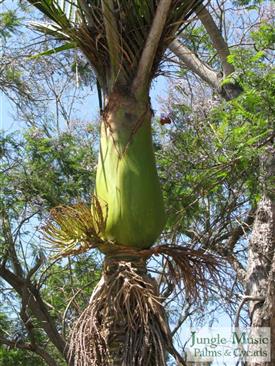
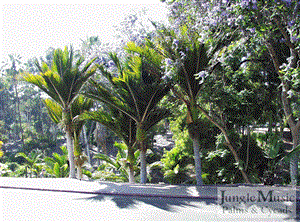
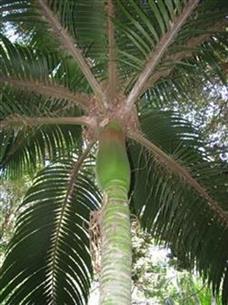
HISTORY OF THE SHAVING BRUSH AND RHOPALOSTYLIS PALMS
The Rhopalostylis sapida, or Nikau Palm of New Zealand, is the southern most palm in the world and native to New Zealand. There it sees very temperate weather. It’s never too hot nor too cold. But, if we go back about 23 million years ago in the Miocene Era, New Zealand was much warmer and more tropical. Fossils in New Zealand seem to indicate it even had a type of native Coconut Palm. The vegetation then was much more lush. With cooling over the eons, many of the tropical species were lost. But, the Nikau Palm remained. When the Polynesian ancestors of the Maori tribes came to New Zealand, they were used to finding Coconuts on most islands. But, in New Zealand, all they found were Rhopalostylis with no edible fruit. Some ancient translations of the “Nikau” palm apparently have definitions including “without nuts or coconuts” by report. Since that time, as the local Maori ancestors and later the Europeans settled into New Zealand, they came to love and appreciate the beautiful stands of Rhopalostylis that remained as the remnants of a more tropical era.
NATIVE HABITAT OF THE SHAVING BRUSH OR NIKAU PALM, RHOPALOSTYLIS SAPIDA AND THE NORFOLK ISLAND PALM, RHOPALOSTYLIS BAUERI
Native stands of Rhopalostylis sapida are found in temperate parts of New Zealand and also on coastal areas of Chatham and South Islands. In these localities it is found in shaded forests and in the more moist bottoms of mountainous gullies. One does not see it at high elevation where severe cold may be seen. Rather it’s in the coastal and warmer regions. Being a slow growing species, it is reported that it takes ten to fifteen years in habitat before one begins to see a formed trunk. One report done by the New Zealand government reported that it took forty years to show trunk and that ten meter trees were 200 years old. The point here is that, as a species, the Nikau Palm is slow growing in its natural habitat. Soil in the area is good draining and rainfall is ample.
Rhopalostylis baueri, the Norfolk Island Palm, is native to two locations. Norfolk Island (an Australian island) is the home of the classic Rhopalostylis baueri but there is also a population in Kermadec Islands, a New Zealand territory. The population of Rhopalostylis baueri on Norfolk Island is near the elevated center of the island, rare elsewhere. In this locality, it is threatened by rodents that eat the seeds and young seedlings. In the Kermadec location, this species is found on Raoul Island. It is more plentiful there because there have been efforts to eliminate the rat population. Of note, it is this population of Rhopalostylis from the Raoul Island of the Kermadecs that were, at one time, considered to be Rhopalostylis cheesemanii. In 2005 the latter was stripped of its species categorization and named a “variety” of R. baueri.
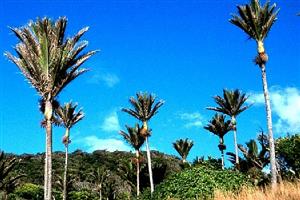

by Palm & Cycad Soc. of New Zealand
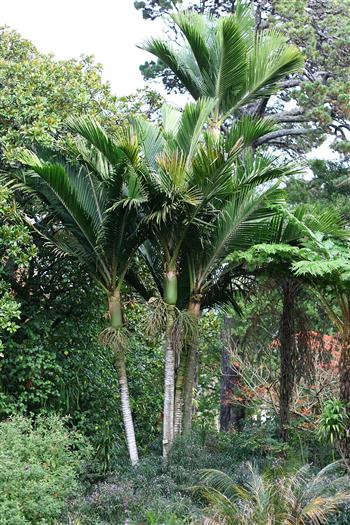
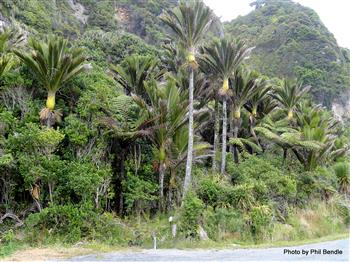
by Palm & Cycad Soc. of New Zealand
DESCRIPTION OF THE RHOPALOSTYLIS SPECIES
RHOPALOSTYLIS SAPIDA
THE NIKAU, SHAVING BRUSH AND FEATHER DUSTER PALM
GENERAL DESCRIPTION OF RHOPALOSTSYLIS SAPIDA
This is a single trunk palm that has green, upright leaves. The hallmarks of this plant are the upright pointing leaves and the swollen crown shaft. Almost always, the crown shaft is prominently larger in diameter than the trunk. The trunk has rings from old leaf attachments. Overall height after many decades is 25 to 35 feet or, on old specimens, even more. Trunk diameter is eight to twelve inches. Leaves are usually eight to twelve feet long. Growth rate is slow.
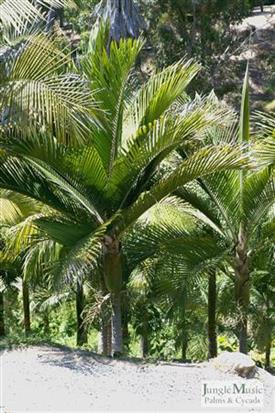

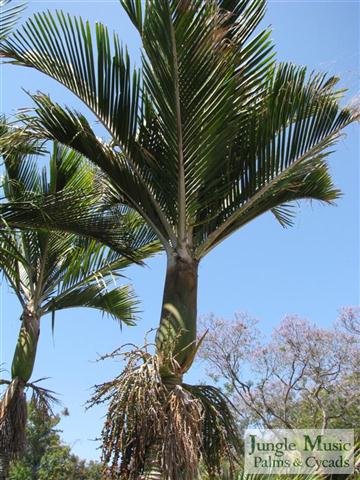
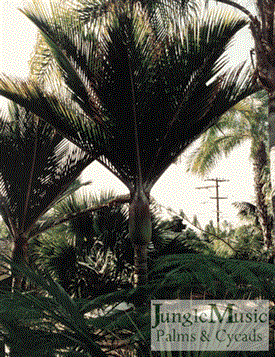
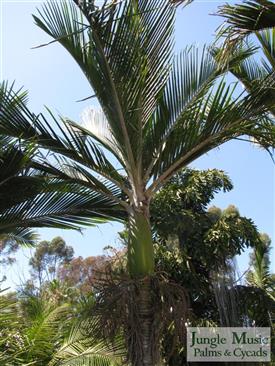
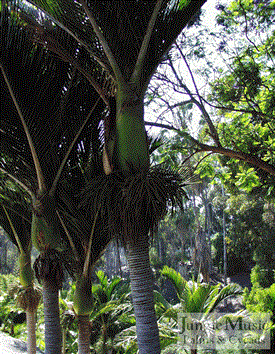
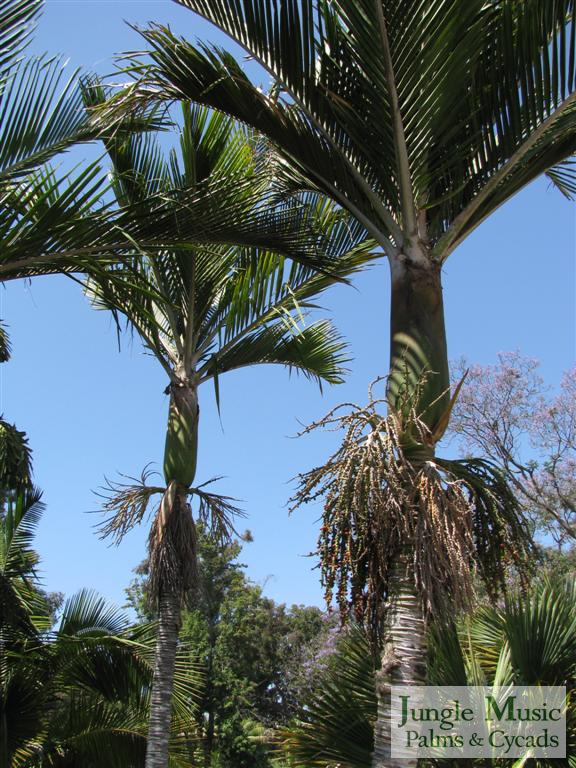
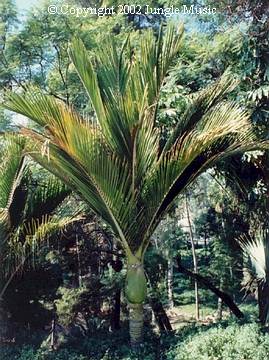
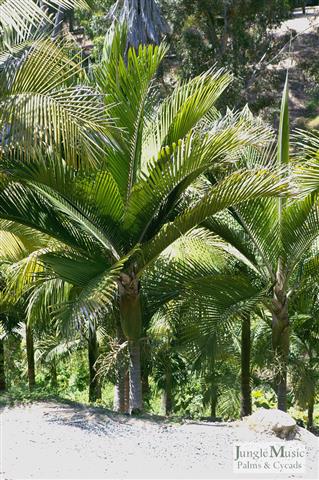
LEAVES OF THE RHOPALOSTYLIS SAPIDA
Leaves are green in color and minimally arched, if at all. The entire crown of leaves usually points upwards except on older dependent leaves. The petiole and rhachis has a gray color. The bare petiole next to the trunk is very short. Compare this to R. baueri which has a longer bare petiole. In other words, the leaflets of the Nikau Palm crowd down more closely to the trunk. Also, leaves of the Shaving Brush Palm are slightly keeled in cross section but may be near flat as well. Leaf length is eight to twelve feet.
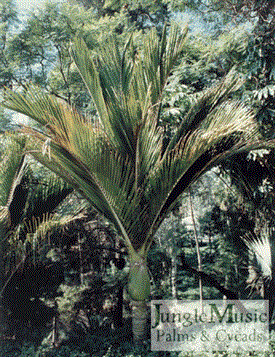
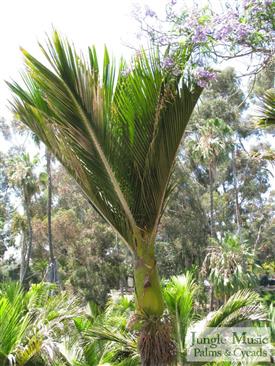
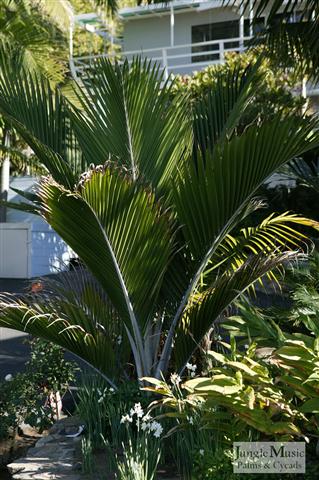
CROWN SHAFT OF RHOPALOSTYLIS SAPIDA
As mentioned, the crown shaft of this species is swollen. Sometimes this is dramatic. The diameter of the crown shaft can be almost double to the trunk diameter (see first photo below). More often, it is a moderate but very visible bulge. The crown shaft color is a light green. Flower emerge below the crown shaft as shown in the second picture below.
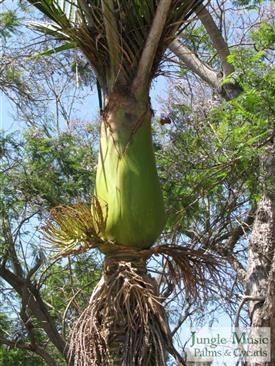
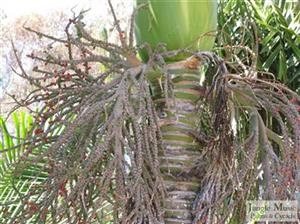
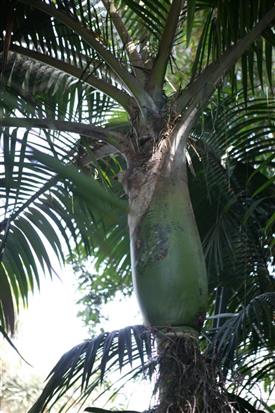
TRUNK OF THE RHOPALOSTYLIS SAPIDA
The trunk of Rhopalostylis sapida is anywhere from eight to twelve inches thick. It can retain a green color if it isn’t hit by direct sun. In the sun it turns tan. It’ll show light colored rings, especially if the trunk isn’t in sun. The crown shaft is at the top of the trunk, below the leaves. Trunk formation, as mentioned above, is very slow on the Shaving Brush Palm.
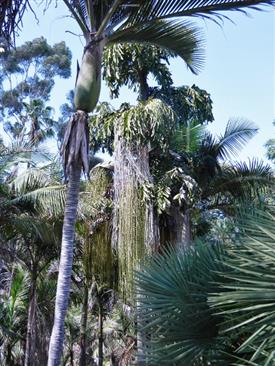
of the sun exposed trunk.
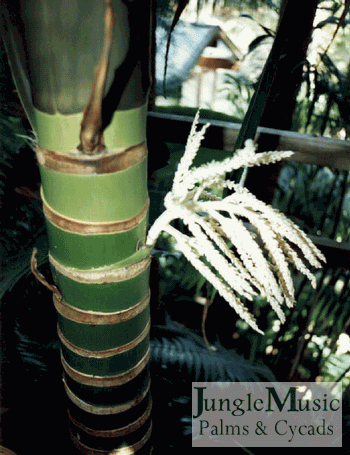
rings
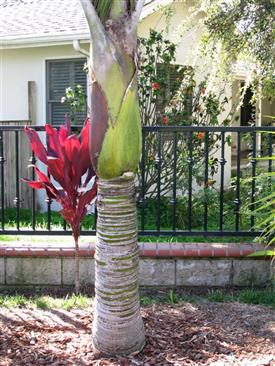
FRUITS AND SEEDS OF THE SHAVING BRUSH PALM
This is a monoecious species of palm tree. This means that a single tree has both male and female flowers. Therefore, a single tree can produce viable seeds. Flowers emerge right below the crown shaft and are branched and purple and white in color. Pollen is dispersed from mature male flowers to the female flowers by wind or insects. Immature seeds are green in color. At maturity, the fruit is red in color and the seeds within the fruit are tan. Cleaned seeds are not large, under one half an inch in length.
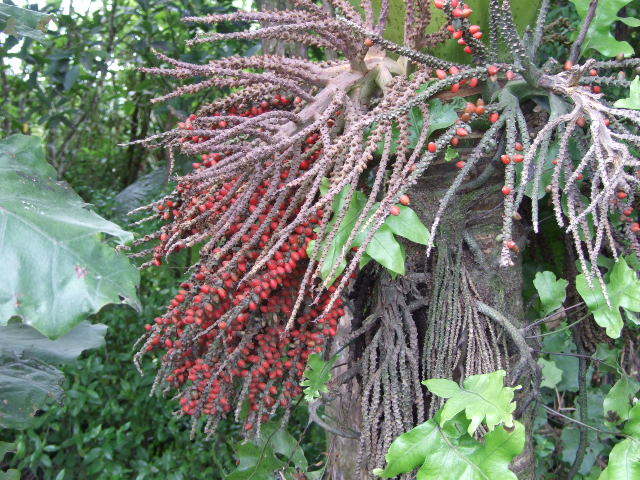
RHOPALOSTYLIS BAUERI,THE NORFOLK ISLAND PALM
GENERAL DESCRIPTION OF RHOPALOSTYLLIS BAUERI
The most marked differences between Rhopalostylis sapida and R. baueri are:
•The crown shaft of the Norfolk Island Palm is not as swollen as the Nikau Palm. There is some bulge, but it is less pronounced.
•The leaves are arched toward the ground. As R. sapida leaves are generally pointing upwards, the crown of baueri is more full and rounded with some leaves, especially older ones, curving downwards.
•Leaves tend to have more bare petiole closer to the stem than R. sapida. This is very apparent on juvenile plant. In other words, leaflets don’t continue proximally on the leaf stem to crowd the stem next to the trunk.
•There is a brown or red-brown color to the proximal leaf stem on the Norfolk Island Palm (the Nikau is more gray). This is also most apparent on juvenile trees.
Leaf color of the Norfolk Island Palm is green, similar to R. sapida. Overall mature height is also quite similar, thirty feet being an exceptionally old tree.
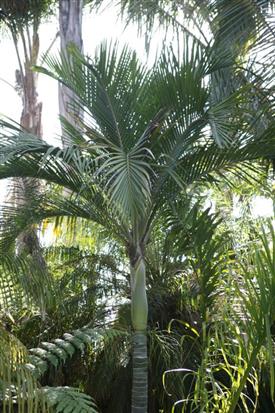
Rhopalostylis sapida
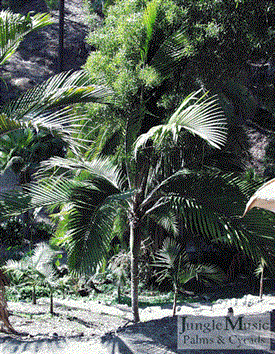
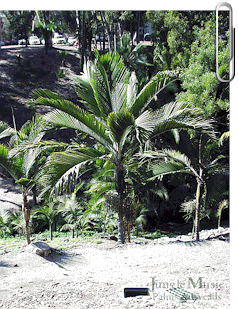
LEAVES OF RHOPALOSTYLIS BAUERI
The main thing about the crown of leaves of Rhopalostylis baueri is that it is more open than R. sapida. The latter has all of it’s leaves in an upward orientation. If you think of the crown as a 360 degree circle, then the leaves are found in only about 1/3 of this circle. With Rhopalostylis baueri, the leaves occupy 1/2 or more of this circle. So, the ten to fifteen leaves in the crown appear more open. Also, the leaves have a bend or curve toward the ground. They are arched. Lower dependent leaves may be below the mid-crown position. Leaves individually are eight to twelve feet long, green in color and mildly keeled in cross section. There are no spines.
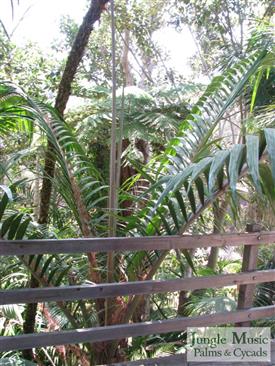

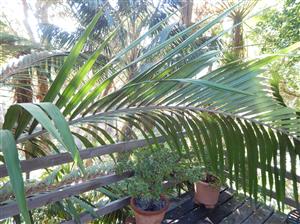
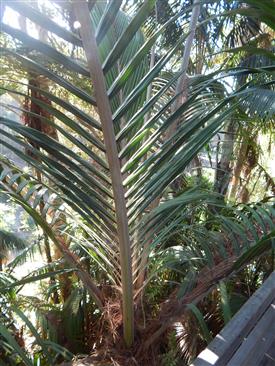
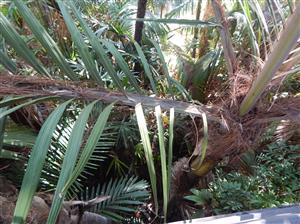
TRUNK AND CROWN SHAFT OF RHOPALOSTYLIS BAUERI
The trunk of the Norfolk Island Palm is similar to that of the Nikau Palm. But, because it’s usually grown in part day sun or filtered light, it may be thinner. Trunk diameter is usually six to ten inches. If grown in the shade, the trunk will retain a dark green color with prominent growth rings. With sun exposure, the trunk will turn a tan color. Movement of a trunked specimen from shade to sun may result in black splotches of sun burn on the trunk. The crown shaft of Rhopalostylis baueri is usually less bulging and large as sapida. But, there can be exceptions. Crown shaft color is a yellow green to a dark shiny green. On the photos below note the minimal bulge to the crown shaft and the flower emergence directly below the crown shaft at the top of the trunk. On those plants not in full sun, also note that the trunk color is green.

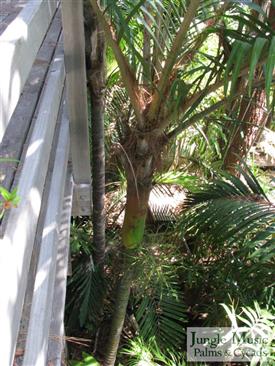
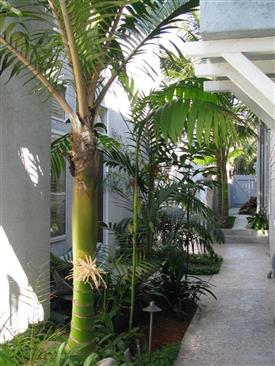
Rhopalostylis sapida

FLOWER AND SEEDS OF RHOPALOSTYLIS BAUERI
The flowers of the Norfolk Island Palm are branched and appear at the upper trunk. Seeds are globular and red in color. A well grown specimen can produce hundreds of seeds. This is a monoecious species so only one plant is needed to set seeds. Emerging flowers are white or a light tan in color.
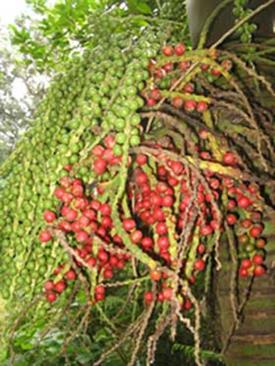
Zealand Plant Conservation Network

Palmpedia unknown author
OTHER VARIETIES OR SUB-SPECIES OF RHOPALOSTYLIS
RHOPALOSTYLIS CHEESEMANII FROM RAOUL ISLAND
The main historical controversy has been over the native population of Rhopalostylis located on Raoul Island, part of the Kermadec Islands of New Zealand. Because of patriotism, New Zealanders would certainly like to consider this population a species all to itself. But, most people now consider it to be a variety of Rhopalostylis baueri, the Norfolk Island Palm. Of course, the use of this common name doesn’t set well with those from New Zealand. They would argue that the things different include more round and larger fruit, and brown hairs present on the crown shaft. Also, some say it’s a more robust growing species. If you wish to recognize it as a different palm, right now the correct name would be Rhopalostylis baueri var. cheesemanii or kermadescensis.
RHOPALOSTYLIS OCEANA FROM CHATHAM ISLANDS
Another example of a population seeking “species status” would be the Rhopalostylis population from Chatham Island. Because this island is so far south, it is the species that is recognized as being the “most southerly of any palm species”. Compared to the regular Nikau, this population shows amazing speed and vigor of growth and gets a larger trunk with a fatter, very swollen crown shaft.
OTHER VARIETIES OF RHOPALOSTYLIS SAPIDA
As on travels from location to location throughout the many habitats of Rhopalostylis sapida, there are individual differences from one habitat population and the next. Although these differences don’t merit individual species status, they are interesting to the enthusiast. These includes plants from the Little Barrier Island, the Great Barrier and the South Island. I’ll show a few photographs below of some of these.
And, finally, I must mention hybrids. This is most often seen when seeds are collected from domestic plants where two or more species are planted nearby. I would on occasion get seeds from Jim Wright, now a deceased palm legend and pioneer. He had flowering R. sapida and baueri in close proximity. When grown, they did look like a cross of the two – something inbetween. But, they had classical “hybrid vigor” when grown.
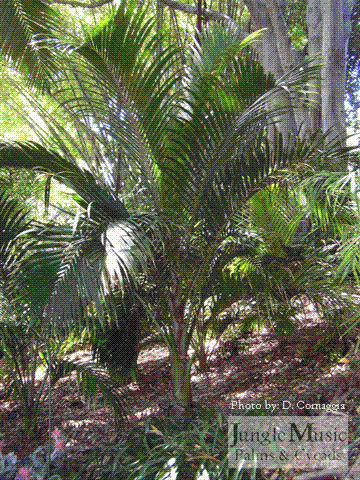
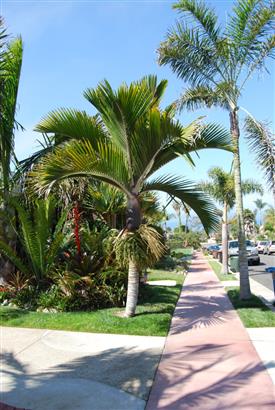
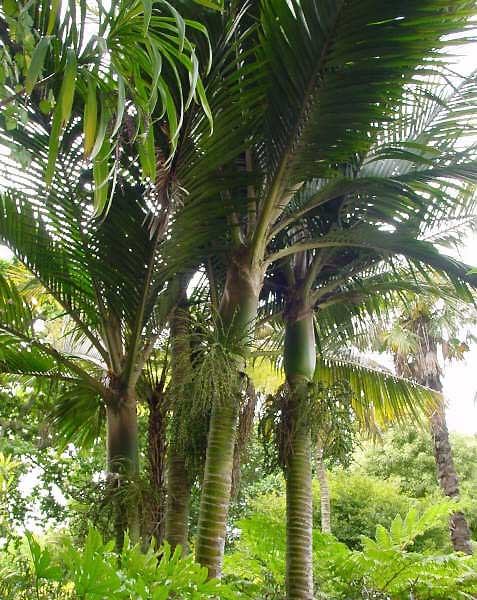
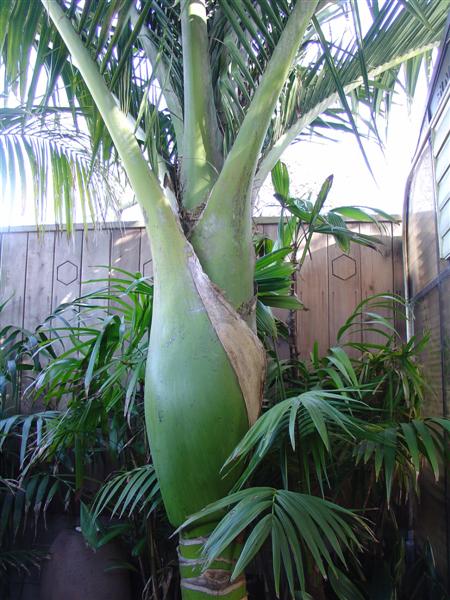
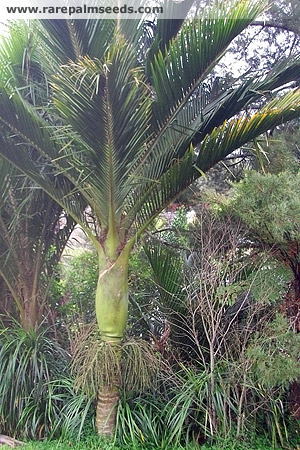
by TS at RPS
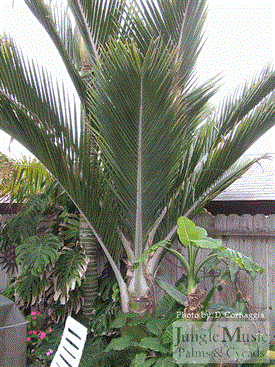
CULTURE OF AND GROWING RHOPALOSTYLIS PALMS
Sun Requirements: Sun tolerance totally depends on where you live. Right along the coast in our locality, Rhopalostylis sapida will take full sun. But, as you move inland, it does less well with full sun. With nursery customer feedback, we’ve determined that about eight miles from the ocean is the limit to where plants tolerate full sun. Further inland requires part day sun or strong filtered light. Rhopalostylis baueri is felt by most to be good for part day sun or filtered light although some have grown it in full sun near the ocean.
Cold Tolerance: As a group, Rhopalostylis are moderately cold hardy. They are one of the most cold hardy of all crown shafted palms. Using Rhopalostylis sapida at the prototype, I’d estimate that, with good culture, this palm will tolerate temperatures in the low 20’s F., perhaps as low as 20 degrees.
Heat Tolerance: Interestingly, this is a species of palm that can take some degree of heat but may fail with extreme heat like you’d see in desert environments. Also, the combination of high humidity and heat is hard on Rhopalostylis. Thus, it’s almost impossible to grow these palms in South Florida.
Speed of Growth: As mentioned below, in habitat, it can take fifteen years to begin to establish a trunk. This is impressively slow. It’s not that plants don’t produce new leaves, they are just slow to produce trunk. So, when an enthusiast or landscape architect calls for a 36 inch boxed Nikau with five to six feet of trunk, you’re looking at a 30 year old container grown plant at the least. How many nurseries would hold a plant for 30 years waiting for this inquiry? A buyer must be realistic. In the ground, plants are faster but are so much slower than almost any other palm species that one just has to be patient. In temperature regions growth rate in the ground is slow to medium. But, remember that this is not a very tall mature tree. So, take this into consideration. From a small plant (i.e. seedling), growth in our area would take at least eight to ten years to begin trunk formation.
Water Requirements: I’d comment that I would not consider these palms to be water conserving. They come from cooler areas where rainfall is ample. We recommend giving them ample water for a beautiful specimen. It’ll also probably increase growth rates as well.
USAGE OF RHOPALOSTYLIS PALMS IN THE LANDSCAPE
If one reviews growth rates described above, you’ll recall that growth rates are slow. So, usage of these palms may be limited by what one wants to accomplish and what starting size is desired. The largest plants on the market will probably be 24 inch boxes with no existing trunk.
With this said, a collector who “wants this species” doesn’t care. He’s willing to start with a moderately sized plant. Patience pays off over time. If you don’t get what you can, you’ll never have one. Most would plant Rhopalostylis as a single specimen. If one desires a colony, he should give ample spacing between plants. A tightly placed multiple would hide the beauty of each individual plant. Anticipate that, from a nice 15g or 24 inch box, you’ll have a good looking specimen in about 15 years if all goes well with culture.
RHOPALOSTYLIS AT THE NURSERY
We usually have available a reasonable selection of various species and sizes of Rhopalostylis and its varieties. The photos below are representative of nursery stock. I’ll make comments below some to point out characteristics mentioned above. Sometimes these unique traits are more pronounced on juvenile nursery plants. But, it’s easy to spot differences when you get used to them.
RHOPALOSTYLIS SAPIDA, THE SHAVING BRUSH, FEATHER DUSTER
OR NIKAU PALM
As you look at the nursery plants below, note the upright leaves on this species. In a way, they are sort of “crowded”. Also, note the gray color to the leaf stems. If you spot these two traits, you can identify them compared to the Norfolk Island Palm.

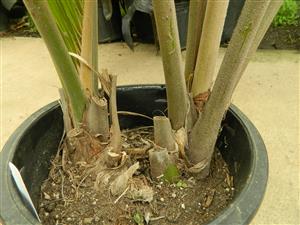
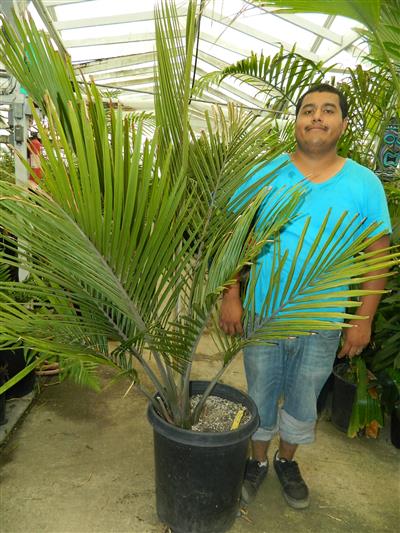
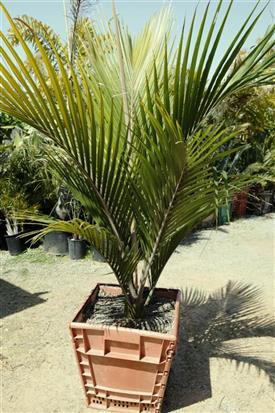

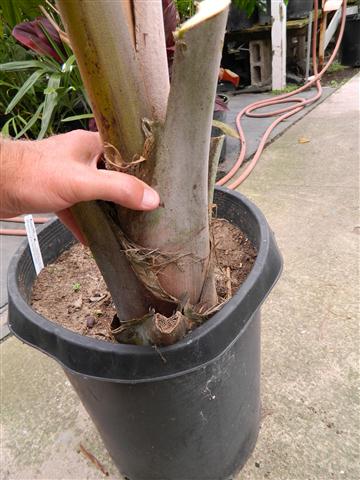
RHOPALOSTYLIS BAUERI, THE NORFOLK ISLAND PALM
On the Norfolk Island Palm note how, especially on nursery stock, there is a definite bare petiole. I.e., there’s no leaflets for a bit adjacent to the center of the plant. Also note how the leaf stems (petioles) have a red-brown look to them. I’m showing an assortment of sizes.

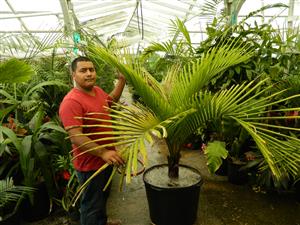
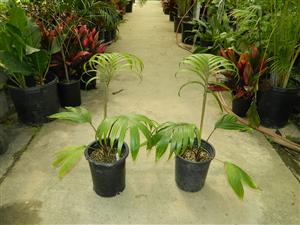
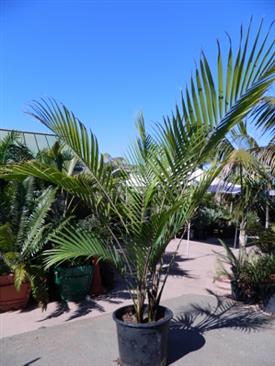
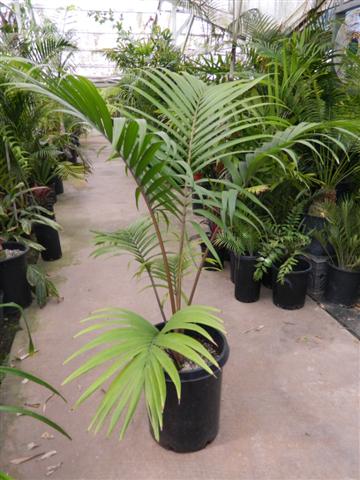
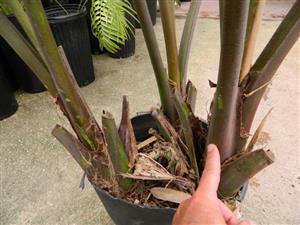
RHOPALOSTYLIS OCEANA – CHATHAM ISLAND

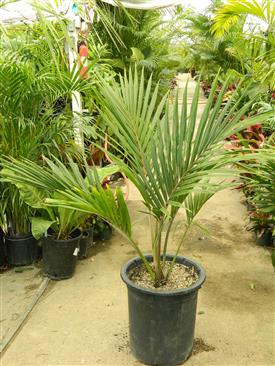
CONCLUSION
Rhopalostylis is a genus of single trunk, prominently crown shafted pinnate palms from New Zealand and surrounding areas. There are two main species, Rhopalostylis sapida and baueri. The former is known as the Nikau Palm, Shaving Brush Palm or the Feather Duster Palm. Rhopalostylis baueri is known mostly by the locality nearer to Australia, the Norfolk Island Palm. These are slow growing but gorgeous palms. They can tolerate relatively low temperatures and be grown in Northern California. One must determine how much sun any given plant is to receive. As a rule, these plants look best when planted as a single specimen. Nursery stock plants are shown.
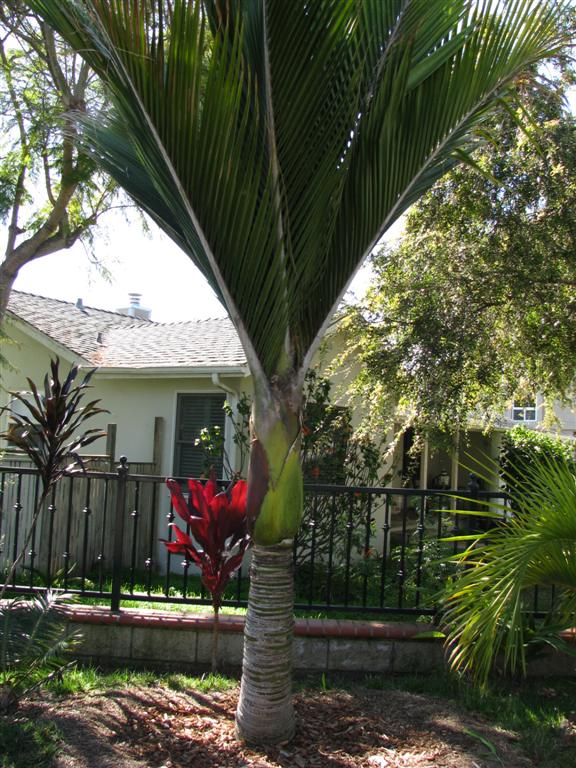
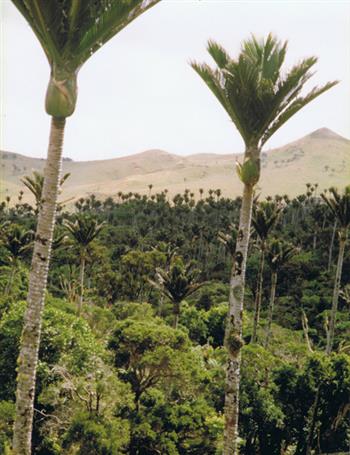
Of New Zealand
Thank you for reading this article
Phil Bergman
Jungle Music Palms, Cycads and Tropical Plants
- PALM TREES, CYCADS & TROPICAL PLANT BLOG - October 1, 2020
- TRACHYCARPUS
The Windmill Palm - September 30, 2020 - FAN PALMS –
PALMS WITH CIRCULAR LEAVES - September 29, 2020












